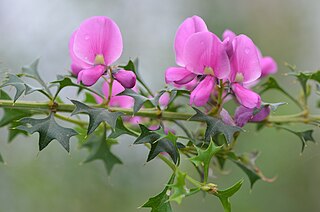
Chorizema, commonly known as flame peas, is a genus of flowering plants in the family Fabaceae and is endemic to Australia.

Banksia nivea, commonly known as honeypot dryandra, is a species of rounded shrub that is endemic to Western Australia. The Noongar peoples know the plant as bulgalla. It has linear, pinnatipartite leaves with triangular lobes, heads of cream-coloured and orange or red flowers and glabrous, egg-shaped follicles.

Eucalyptus cornuta, commonly known as yate, is a tree species, sometimes a mallee and is endemic to the southwest of Western Australia. It has rough, fibrous bark on all or most of its trunk, smooth bark above, mostly lance-shaped adult leaves, elongated flower buds in groups of eleven or more, yellowish flowers and cylindrical to cup-shaped fruit. It is widely cultivated and produces one of the hardest and strongest timbers in the world.
Relation du Voyage à la Recherche de la Pérouse is an 1800 book that gives an account of the 1791-1793 d'Entrecasteaux expedition to Australasia. The title refers to the search for La Pérouse, who disappeared in the region in 1788, a popular, though unsuccessful, object of the mission. Many of the discoveries made by the scientists attached to the expedition were published in the two volumes. The author, Jacques Labillardière, was a French botanist on the voyage, engaged to collect and describe the flora of the continent. The work includes some of the earliest descriptions of Australian flora and fauna, and an account of the indigenous peoples of Tasmania.

Chorizema cordatum, commonly known as heart-leaf flame pea, is a species of flowering plant in the family Fabaceae and is endemic to the southwest of Western Australia. Noongar people know the plant as kaly. It is a woody, erect, scrambling or climbing shrub with heart-shaped leaves, the flowers usually brightly coloured in yellow, orange and red.

Podolobium ilicifolium, commonly known as prickly shaggy-pea, is a flowering plant in the family Fabaceae and grows in eastern and southern Australia. The inflorescence is a cluster of yellow or orange pea-like flowers with red markings and shiny green, prickly foliage.

Pultenaea juniperina, commonly known as prickly bush-pea or prickly beauty is a species of flowering plant in the family Fabaceae and is endemic to south-eastern Australia. It is an erect, spiky shrub with hairy stems, linear to narrow elliptic leaves with stipules at the base, and yellow-orange and red flowers.

Pultenaea tenuifolia, commonly known as slender bush-pea, is a species of flowering plant in the family Fabaceae and is endemic to southern Australia. It is a spreading or low-lying to prostrate and mat-forming shrub with hairy branches, narrow lance-shaped leaves, and yellow to orange and red, pea-like flowers.

Hovea chorizemifolia, commonly known as the holly-leaved hovea, is a species of flowering plant in the family Fabaceae and is endemic to the south-west of Western Australia. It is a small, upright shrub with prickly, green leaves and blue-purple pea flowers.

Hibbertia acicularis, commonly known as prickly guinea-flower, is a species of flowering plant in the family Dilleniaceae and is endemic to eastern Australia. It is an erect or prostrate shrub with linear to lance-shaped leaves and yellow flowers arranged singly in leaf axils with the six to eight stamens joined at the base, in a single cluster.

Mirbelia dilatata, commonly known as holly-leaved mirbelia, is a species of flowering plant in the family Fabaceae and is endemic to the south-west of Western Australia. It is an erect, bushy, shrub with prickly leaves and pink, purple or violet flowers.

Chorizema parviflorum, commonly known as eastern flame pea, is a species of flowering plant in the family Fabaceae and is endemic to eastern Australia. It is an erect shrub with linear to narrowly egg-shaped leaves and yellow and reddish flowers arranged in racemes on the ends of branches.

Chorizema carinatum is a species of flowering plant in the family Fabaceae and is endemic to the southwest of Western Australia. It is an erect or spreading shrub with sharply-pointed leaves and bright yellow flowers.

Chorizema cytisoides is a species of flowering plant in the family Fabaceae and is endemic to the southwest of Western Australia. It is an erect to low-lying or sprawling shrub with linear leaves and reddish-orange, yellow and purple flowers.

Chorizema dicksonii, commonly known as yellow-eyed flame pea, is a species of flowering plant in the family Fabaceae and is endemic to the southwest of Western Australia. It is an erect or spreading shrub with oblong to lance-shaped leaves and red and orange flowers.

Chorizema diversifolium is a species of flowering plant in the family Fabaceae and is endemic to the southwest of Western Australia. It is a twining or trailing shrub or climber with variably-shaped, egg-shaped to narrowly lance-shaped leaves and pink, orange and red flowers.

Chorizema glycinifolium is a species of flowering plant in the family Fabaceae and is endemic to the south-west of Western Australia. It is a slender, erect or sprawling shrub with variably-shaped leaves and orange, pink or red flowers with yellowish markings.

Chorizema humile is a species of flowering plant in the family Fabaceae and is endemic to the southwest of Western Australia. It is a sprawling, prostrate or low-lying shrub with egg-shaped or wedge-shaped leaves and yellow and reddish-brown flowers.

Chorizema nanum is a species of flowering plant in the family Fabaceae and is endemic to the south-west of Western Australia. It is a slender, erect to spreading or low-lying shrub with holly-like leaves and yellow and pink, pea-like flowers.

Chorizema nervosum is a species of flowering plant in the family Fabaceae and is endemic to the coast of southern Western Australia. It is an erect or spreading shrub with sharply-pointed, wavy, round to heart-shaped leaves, and yellowish-orange and red pea flowers.



















